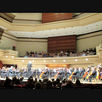Chicago Symphony Orchestra shakes the city with Strum
- Natalia Dagenhart
- Jun 6, 2021
- 4 min read
Updated: Jun 16, 2021
The orchestra’s second concert program, Strum, took place on June 3, 4, 5 and 6 at the Chicago Symphony Center.

Erina Yashima, former CSO Solti Conducting Apprentice, joins the CSO for the opening performance of the program entitled Strum. Photo by: Anne Ryan
By Natalia Dagenhart
“Real art is one of the most powerful forces in the rise of mankind, and he who renders it accessible to as many people as possible is a benefactor of humanity,” said Hungarian composer Zoltán Kodály. The Chicago Symphony Orchestra is happy to resume its live concerts and bring the beauty of classical music back to our city. The orchestra’s second concert program, Strum, took place on June 3, 4, 5 and 6 at the Chicago Symphony Center.
The audience members feel calm and confident attending these concerts as new “Safe and Sound” measures have been adopted to welcome patrons back to Symphony Center. At all times, patrons and staff are required to follow all the necessary safety measures such as wearing face coverings and observing social distancing guidelines when inside the Symphony Center. This concert program, as well as two other programs, is presented for reduced-capacity audiences in Orchestra Hall with safety measures in place in accordance with current state and city COVID-19 guidelines for public events.
I was lucky to attend the Strum concert program last Friday, June 4. The orchestra presented this beautiful program under the baton of German-born conductor Erina Yashima. This young and talented conductor has a great ability to demonstrate a strong connection with the orchestra and particularly with each musician. Her emotions, gestures and overall presentation reflected the mood and the style of each piece and demonstrated her mastership.
Since 2015, Yashima has worked and studied with Maestro Riccardo Muti, and the musicians are familiar with her conducting style and technique. She is a winner of the Chicago Symphony Orchestra’s Sir Georg Solti Conducting Apprenticeship. Yashima also assisted Maestro Muti and worked closely with the Civic Orchestra of Chicago. She is assistant conductor at the Philadelphia Orchestra and performs the role of guest conductor with other orchestras as well.
The Strum concert program started with the touching and sincere music of the prominent composer Samuel Coleridge-Taylor, who was born in 1875 to an English mother and a father originally from Sierra Leone. He fought against racial prejudice with his incredible compositions, and his Novelettes became a great example of that. The Chicago Symphony Orchestra presented the composer’s Novelette in A Minor, Op. 52, No. 3 and Novelette in D Major, Op. 52, No. 4. These were the first Chicago Symphony Orchestra performances of these Novelettes and the audience greeted them with joy.

Erina Yashima, former CSO Solti Conducting Apprentice, leads a program of works featuring the strings of the Chicago Symphony Orchestra.
The first one, Novelette in A Minor, was touching, sensitive and sincere. This thoughtful, yet moving and emotional composition touched everyone’s heart. The second one, Novelette in D Major, sounded energetic and confident, with happy notes, dancing motives and sometimes with changing tone and color. Overall, these two pieces demonstrated the two beautiful parts of the composer’s bright personality and talent.
The program continued with Symphony No. 5 by famous Austrian composer Franz Schubert. He wrote it in 1816 at the age of 19. At that time Schubert was particularly impressed by the music of Mozart, and the audience was able to hear some similarities between this symphony and the style of Mozart. This four-movement composition consists of Allegro, Andante con moto, Menuetto: Allegro molto, and Allegro vivace, and each movement brought its own beauty and charm to the audience.
Allegro impressed me with its peaceful and glorious mood and inner tension. Andante con moto demonstrated an elegant melody that was beautifully developed and repeated. To me, the sounds of Menuetto showed pathos and elegance at the same time, while leaving some space for calmness with hidden inner strength and power. Allegro vivace was fast and streamy, elegant and moving. The beauty of this symphony with its sudden and transformative modulations and the emotional conversation between the instruments is difficult to overestimate.

CSO second flute Emma Gerstein warms up before the performance.
The next piece, Strum, was written by Jessie Montgomery, a modern American composer. “Drawing on American folk idioms and the spirit of dance and movement, Strum has a kind of narrative that begins with fleeting nostalgia and transforms into ecstatic celebration,” wrote Montgomery about this piece.
The Chicago Symphony Orchestra presented this piece for the first time. Strum caught my attention starting with its first notes. One instrument after another played a tense and emotional theme, and then more instruments joined this musical conversation. The more rich and full the sound, the more significant was the message of this piece. This technically challenging composition was written to make you think, and it’s great!
Dances of Galánta by prominent composer and authority on Hungarian folk music, Zoltán Kodály, concluded this wonderful concert program. In this piece, the composer used the wisdom and the heritage of the people of his country, and I was able to hear it in every note. I almost saw the energetic Hungarian dancers. Musical mastership and the ability to express the composer’s feelings helped the Chicago Symphony Orchestra to demonstrate to the audience the beauty of this composition.
“Music is nourishment, a comforting elixir. Music multiplies all that is beautiful and of value in life,” said Zoltán Kodály. The musicians from the Chicago Symphony Orchestra nourish our souls and comfort our hearts by presenting a great variety of classical compositions that light up our city and multiply the beauty of life.
Natalia Dagenhart
06/05/2021
This article can also be found here:

























Comments